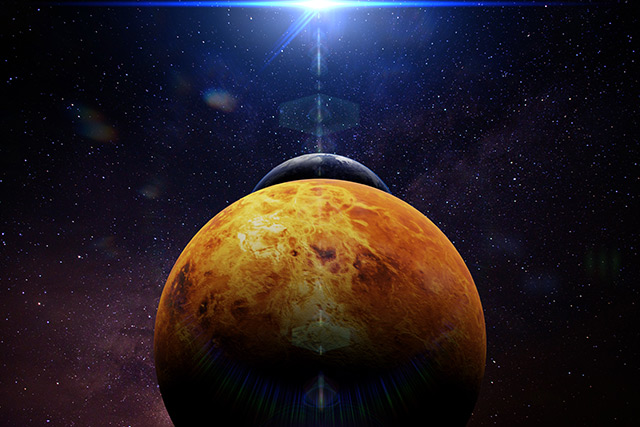Unique “Cocoon Galaxy” also has rare double-nucleus structure
09/13/2021 / By Mary Villareal

New studies show that the Cocoon Galaxy, a galaxy roughly 30 million light-years away from Earth, has two galactic cores instead of the usual single-core found in most galaxies.
After gathering data from optical and radio telescopes based on the ground and in space, a team of astronomers determined that the Cocoon Galaxy (also known as NGC 4490) has a “clear double nucleus structure.”
The pair of galactic cores are said to be the product of an ancient collision between a spiral galaxy and a barred spiral galaxy. The two galaxies, which were drawn together by gravity, collided, triggering a period of active star-building in each cluster.
The study’s first author, Allen Lawrence said: “I saw the double nucleus in NGC 4490 about seven years ago. It had never been observed – or nobody had ever done anything with it before.” (Related: Interstellar space is filled with “toxic grease” that would make future space travel very difficult, say researchers.)
“Some astronomers may have seen one nucleus with their optical telescopes. And others may have seen the other with their radio telescopes. But the two groups never compared notes to observe and describe the double nucleus.”
“One nucleus is visible in the optical, while the other is only visible at infrared and radio wavelengths,” wrote the researchers in their paper. “We find the optical nucleus and the potential infrared visible nucleus have similar sizes, masses, and luminosities. Both are comparable in mass and luminosity to other nuclei found in interacting galaxy pairs and much more massive and luminous compared with typical non-nuclear star-forming complexes.”
The event altered the shape of NGC 4490, leaving the smaller of the two without a semblance of its former spiral shape.
According to Curtis Struck, a professor of physics and astronomy, double-nucleus galaxies are very rare, especially in smaller galaxies such as NGC 4490. He also noted that astronomers think a double nucleus could contribute to the buildup of supermassive black holes found in the center of some galaxies.
Charles Kerton, an associate professor of physics and astronomy and co-author of the study said: “This project demonstrates that using multiple wavelengths from space- and ground-based observations together can really help us understand a particular object.”
Other peculiar galaxies in the universe
With an estimated 100 to 200 billion galaxies in the universe, some oddballs are bound to occur. Here are some of the more peculiar galaxies in the universe.
Galaxy ESO 137-001 (Jellyfish Galaxy)
Located in the constellation Triangulum Australe, ESO 137-001 looks like a giant jellyfish swimming in a sea of stars. The galaxy is a barred spiral galaxy much like our own Milky Way, but it has a streamer of stars that seem to drift like jellyfish tentacles from the center.
Why these stars formed a tail of dust and gas that streams off ESO 137-001 is a bit of a mystery because gases in the tail are deemed to be too hot for star formation.
Andromeda Galaxy (Cannibal Galaxy)
Some galaxies, like the Andromeda Galaxy, are giant cannibals. The Milky Way’s largest neighbor, Andromeda has been devouring smaller galaxies for billions of years. In another 4.5 billion years, it is expected to collide with the Milky Way, although it is not yet clear which one will devour which.
Not to worry though, the human race will be long gone by then; it is expected that the Sun will heat up and make the Earth impossible to live in about 1 billion to 5 billion years from now.
Galaxy W2246-0526 (Thief Galaxy)
Galaxies often interact with one another, but the brightest known galaxy in the universe is a thief. In 2018, scientists found that W2246-0526 sucks up half the mass of three nearby galaxies after they observed streamers of mass connecting all of the galaxies together.
The observation is the most direct shot of galactic cannibalism and is the only known example of a galaxy siphoning mass off more than one neighbor at a time.
Learn more about strange galaxies that can be found in the universe at Cosmic.news.
Sources include:
Tagged Under: astronomy, cocoon galaxy, double nucleus, Galaxies, Good science, NGC 4490, outer space, radio telescopes, science, science explorations, Space, Stars, unique formations
RECENT NEWS & ARTICLES
COPYRIGHT © 2017 SPACE.COM
All content posted on this site is protected under Free Speech. Space.com is not responsible for content written by contributing authors. The information on this site is provided for educational and entertainment purposes only. It is not intended as a substitute for professional advice of any kind. Space.com assumes no responsibility for the use or misuse of this material. All trademarks, registered trademarks and service marks mentioned on this site are the property of their respective owners.




















